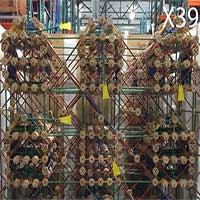Pieces of coal, strange stone, rock and sulfur from hell have helped scientists recreate the day the earth suffered a disaster equivalent to 10 billion atomic bombs.
A team from the University of Texas (USA) and Imperial College London (of the University of London, UK), have extracted the core of matter 1,300m deep from the 66-million-year-old Chicxulub impact crater – the place where the asteroid killed Dinosaurs have “landed” – and discovered many surprises.

Scientists are working with tubes of samples taken from the bottom of the crater – (photo: TEXAS UNIVERSITY).
They found granite, sandstone, limestone, coal, rock and sulfur… in a state they described as “from hell”. Because, when analyzed, these minerals revealed that they were pressed, pinned into the soil at an extremely fast rate , many small pieces of rock that were part of large melted rocks. All helped the research team rewrite the minute-by-minute scenario of the disaster that occurred on Earth.

The minerals were quickly pinned to the bottom of the pit, revealing a lot of information – (photo: IODP).
Professor Sean Gulick (University of Texas) says the objects are “an extended record” of events that he and his colleagues can recover data from to once again look back at the end of the era. dinosaur.
The fateful asteroid, estimated to be 10-15km wide, crashed into Earth at a speed of 70,000km/h, with the force of the impact equivalent to 10 billion atomic bombs. “The impact shook the Earth, causing a widespread inferno,” the authors describe.
Thousands of miles of trees burned in an instant, while a giant tsunami up to 91m high was born from the impact site, sweeping minerals and partially pinning the impact crater as we found. . On the first day alone, material up to 130m thick was deposited in the crater.
A large amount of the rocks were evaporated, throwing about 325 billion tons of gas into the air, creating dense clouds of sulfur that prevented the sun from reaching the ground, causing the Earth to be engulfed in flames again. quickly turned “ice hell”.

Graphic image depicting disaster 66 million years ago – (photo: Don Davis/NASA).
Every living thing on Earth has suffered what the authors describe as “frying them and then freezing them”. According to Professor Gulick, many dinosaurs died on the first day of the disaster. They were burned alive or starved to death. Those that lived longer suffered long cold days and starved to death due to the mass extinction and the destruction of many other plants and animals.
While the impact, wildfire and tsunami killed the creatures around the disaster zone, it was the sulfur clouds that shut the Earth off from sunlight that really caused the global mass extinction.
The most obvious remnant of the disaster is the Chicxulub impact crater off the Yucatan peninsula (Mexico), 185km wide and 32km deep. Half of the hole is under water, the other half is covered by rainforest.
The study has just been published in the journal Proceedings of the National Academy of Sciences (PNAS).

